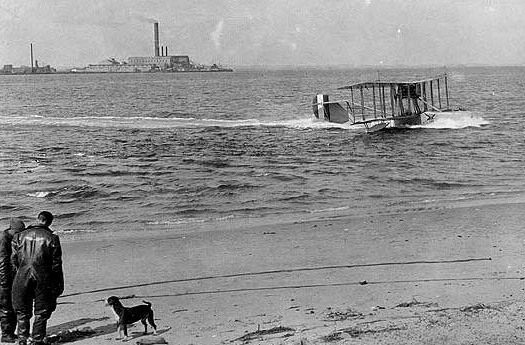
[A seaplane taxis in Jamaica Bay, 1918, with Barren Island in the background; source.]
I recently contributed a short piece to the excellent Fulcrum. The piece begins with a very short version of the bizarre history of Dead Horse Bay and Barren Island — about which I had to leave out eccentric anecdote after eccentric anecdote, such as the night that an entire horse-rendering facility and the horse-meat therein spontaneously combusted, which is perhaps the one that most succinctly encapsulates the alien quality of that ragged fringe of turn-of-the-century New York City — and then it segues into a series of questions about the future of our artificial geologies that may be familiar to any readers who endured my halting and half-formed delivery of these same thoughts on the DredgeFest boat tour. So beginning with the history:
Approximately sixteen kilometers southeast of Manhattan, the southern coast of Brooklyn wraps north along Floyd Bennett Field — a former airfield turned derelict-littered national park — skips across Plumb Beach Channel, and turns west. The small body of water inside this curve is Dead Horse Bay, named for the daily shipments of dead horses it once received from Manhattan. There, on Barren Island, a tight-knit community of immigrants operated an industrial age predecessor to Agbogbloshie, Guiyu, and Chittagong, recycling growing Manhattan’s waste in squalorous conditions. In a city possessed of an entirely different metabolism than modern cities, that waste amounted to an incredible quantity of dead and dying matter, processed in factories, smelters, bone-boilers, guano plants, and open piles. This fetid surplus was converted into an array of chemical products — glycerin, glues, fertilizers, oils — and exported to Europe.
If you want to get to the questions, you’ll want to click through to Fulcrum…
Like most issues of Fulcrum, the issue my piece appears in (#53) has a theme (the Anthropocene) and pairs two authors on that topic (for #53, the other author is Seth Denizen, who contributes a short tale of holes, absence, and soil taxonomies).
Dan Hill recently wrote a short post on Fulcrum, giving it “top marks” for “pushing an agenda and pushing a format in unison, and [doing] both rather adeptly”. Agreed.

